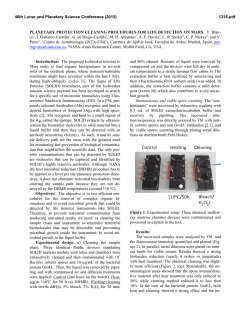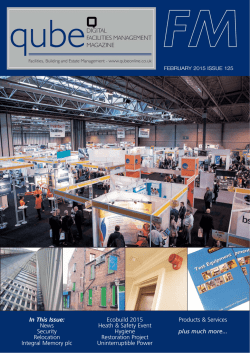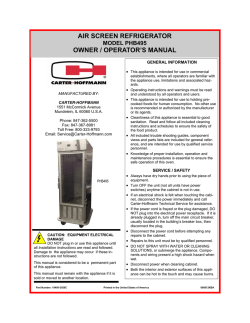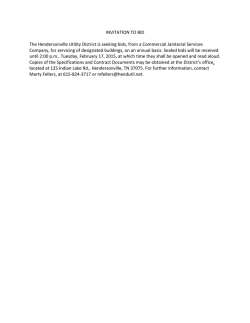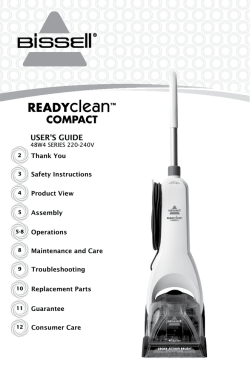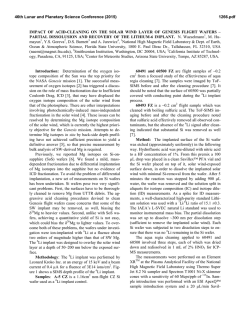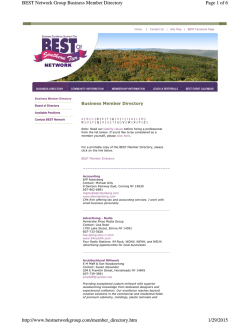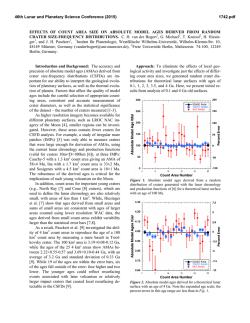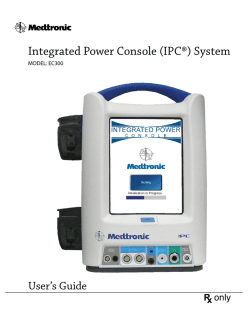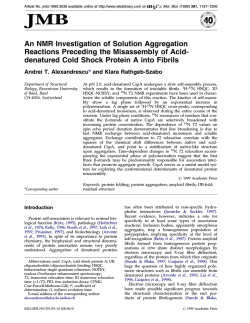
Thinking ahead - Facilitating equipment cleaning
Thinking Ahead Facilitating Efficient Equipment Cleaning Equipment design and cleaning procedures both play a role in thorough sterilization and cleaning Article by Per-Åke Ohlsson, Global Manager, Market Unit Pharma & Personal Care Share this document! Thinking Ahead Facilitating Efficient Equipment Cleaning Equipment design and cleaning procedures both play a role in thorough sterilization and cleaning Sterilization or sanitization is usually applied to kill bacteria in a system. In addition, equipment is cleaned to remove residues from the previous batch of product, and subsequently flushed to remove the cleaning liquids. To ensure that sterilization and cleaning are efficient and safe, it is not enough to develop the appropriate procedures. Selecting the right manufacturing equipment further improves cost efficiency, as well as patient safety. Considerations in Equipment Selection The chosen equipment must minimize the risk of contamination due to inappropriate productcontact surfaces. Machines should not introduce airborne particles and dust into the environment, nor should they entail the risk that oil or other substances required for their operation will contaminate the product. If an operator cannot contact all equipment surfaces adequately, he or she simply cannot clean them. To facilitate efficient cleaning, equipment must be designed with this principle in mind. The time, action, chemicals, and temperature (TACT) circle originally developed by Sinner in 1960 shows the cleaning effects that these parameters generate on the equipment surface (see Figure 1). The circle shows the extent to which time, plus at least one more parameter, clean residues from a surface. If one parameter is increased, the others may be reduced. For example, if one dips one’s greasy hands in water, they will not become clean. If one puts them into a soap bath, they will become clean, but only after a long time. If one raises the temperature of the soap bath, however, one’s hands will become clean more quickly. But if one also rubs one’s hands together, they will become clean even more quickly. The residue and the product-contact surface determine the size, or the impact, needed for the cleaning process. The most suitable type of chemicals and the appropriate temperature are decided according to the residue. High surface action enables the Facilitating Efficient Equipment Cleaning chemicals and temperature to work more efficiently, which makes it possible to reduce both of these parameters, as well as the cleaning time. Because the action is often built into the equipment design, selecting the right equipment can reduce the cost and increase the cleanability of a system. Cleaning action on the equipment surface is achieved by generating high velocity or flow of cleaning fluids on all product-contact surfaces. This technique distributes the chemicals and temperature better than low velocity does. Increased velocity also generates high turbulence and shear force on the surface, which ensures that the chemicals and temperatures reach deep into the residues and dissolve or detach them safely and efficiently. Figure 1. The time, action, chemicals, and temperature (TACT) circle Time Action (flow) Chemistry Temperature 2 Thinking Ahead Testing TACT Parameters To test the influence of the TACT parameters, the author designed a tank-cleaning test incorporating two tank-cleaning devices that generated different amounts of action. A static spray ball typically generates a wall shear stress of 2 – 5 Pa (i.e., falling filmstress, depending on liquid temperature). A rotating jet head typically generates f 40 –1000 Pa (i.e., jet impingement, depending on jet pattern mesh). To clean the tank sufficiently, two static spray balls operated for 48 min at a flow rate of 20 m3/h and a system pressure of 2.5 bar. One rotating jet head, however, achieved better resultswhen it operated for 14 min at a flow rate of 6 m3/h and a system pressure of 5.0 bar (see Table I, Image 1 & 2, Figure 2 & 3). The test showed that the theory of the TACT circle works in practice. To clean a certain residue from a certain surface, the parameters in the TACT circle can be adjusted for cost optimization (see Figure 3). With increased action, it was possible to reduce the time, the amount of chemicals, and the heating energy and still achieve an equal or better result. High shear forces can remove residues from most surfaces by themselves without chemicals or high temperatures. This technique can reduce the risk of contamination from cleaning chemicals and dramatically reduce cleaning costs. Table 1. Parameters of two cleaning operations Parameters Two static spray balls One rotating jet head Time 48 minutes 14 minutes Action (i.e., wall shear stress) 3 Pa 50 Pa Amount of cleaning liquid 16,000 litres 1,400 litres Heating energy 913 kW 73 kW Image 1 & 2. A tank cleaned with two static spray balls (1.) and one rotating jet head (2.) Image 1. Image 2. Figure 2 & 3. TACT circles for two static spray balls (1.) and one rotating jet heat (2.) Time Action (flow) Chemistry Temperature Figure 2. Facilitating Efficient Equipment Cleaning Figure 3. 3 Thinking Ahead Equipment design pitfalls Pockets and crevices. No rule of thumb governs the depth of pockets and crevices. Figure 6 shows a typical crevice found in pharmaceutical systems. Many guidances state that crevices should be avoided or eliminated when possible, a statement that seems weak considering that a crevice could be likened to a dead leg with an L/D measurement of 50 –100, compared with the normal 2 – 3. Following Haga et al., it would be impossible to achieve the velocity required to clean the bottom of a crevice. Thus, pockets and crevices should not exist in pharmaceutical systems because they will always pose a major contamination risk. Cleanable 1 1.5 2 2.5 Figure 5. Velocity and length/diameter measurement Flow rate (m/s) In a 1997 article, Haga et al. presented results from tests with various velocities in the main pipe in various L/D measurements1. They found that for an L/D of 6, it is possible to clean the residue adequately if the main-pipe velocity is higher than 1.5 m/s. They also found that for an L/D of 3, it is impossible to remove the residue if the main pipe velocity is lower than 0.7 m/s (see Figure 5). Residue Uncleanable 0.5 Dead legs. It is widely understood that dead legs should be avoided or minimized in a system (see Figure 4). Some guidance states that the length to diameter (L/D) measurement for dead legs should not be more than 2, and, in some cases, not more than 3. The relation between the main-pipe velocity and the L/D measurement, however, is often overlooked. High main-pipe velocity makes the turbulence go deeper into the dead leg, and if the turbulence or action is strong enough, it will remove the residues at the bottom of the dead leg. Figure 4. Dead leg 0 Strong cleaning action on all product contact surfaces minimizes the risks of contamination and of system malfunction and also enables cost efficient cleaning. Common design pitfalls, however, impair equipment cleanability. Dead legs, pockets and crevices, air pockets, and improper equipment surfaces are pitfalls too often seen in the pharmaceutical industry. 3 4 5 6 7 8 Dead end length ratio L/D (-) Figure 6. A hard-to-clean pocket A hard-to-clean pocket can be created between two metal parts and an O-ring seal. Facilitating Efficient Equipment Cleaning 4 Thinking Ahead Air pockets. Air pockets may be described as upside-down dead legs or crevices (see Figure 7). Although residues do not collect in an air pocket, they stick to its surface. It is difficult to evacuate the air from these pockets during the cleaning process, which means that the cleaning liquid will not reach the top of the air pocket and, accordingly, will not clean it. Air pockets, therefore, must be eliminated, or they will introduce a high risk of contamination. Surface finish. Surface finish is often considered a measurement of hygienic design. The maxim is that the smoother the surface, the more hygienic and easy to clean. But this principle is, in fact, open to debate. A 2003 study by Hilbert et al. tested the adherence of bacteria to several surfaces and the cleanability of these surfaces2. The surfaces, from 0.1 μm electro-polished to 0.8 μm mechanically polished, showed no differences in adherence or cleanability. The main reason was the relatively large size of the individual bacteria compared with the small size of the surface imperfections. As long as the surface finish is below Ra 0.8 –1.0 μm, the bacteria are too large to get trapped between the surface imperfections. In another study, however, Riedewald showed that when bacteria accumulate in a biofilm, adherence and clean ability depend on the surface finish3. It is hard for biofilm to attach to a smooth surface, and thus it is easy to detach them from such a surface. Figure 7. Typical air pocket Air pocket The same is true for other sticky residues. A study at the Institute of Technology in Kolding, Denmark, tested the cleanability of surfaces spiked with a yogurt solution that had been ovendried4. This study clearly showed that a surface with a low Ra value was easier to clean than one with a high Ra value. The tested surfaces ranged from Ra 0.15 to 2.4 μm. Electropolished surfaces also were easier to clean than mechanically polished surfaces, which, in turn, are easier to clean than pickled surfaces. Equipment designed correctly will avoid the above pitfalls, thus facilitating safe and cost-efficient cleaning. The more cleaning action is applied on all product-contact surfaces, the easier, safer, and quicker system cleaning will be. References. 1. R. Haga et al., Pharm. Eng. 17 (5), 8–21 (1997). 2. L.R. Hilbert et al., Int. Biodeterior. Biodegradation 52 (3), 175–185 (2003). 3. F. Riedewald, PDA J. Pharm. Sci. Technol. 60 (3), 164–171 (2006). 4. D. Bagge-Rawn, Microbial Adhesion and Biofilm Formation in the Food Processing Industry (Technical University of Denmark, Kolding, Denmark, 2007). Facilitating Efficient Equipment Cleaning 5 About Alfa Laval Alfa Laval is a leading global provider of specialized products and engineered solutions that help customers heat, cool, separate and transport products such as oil, water, chemicals, beverages, foodstuffs, starch and pharmaceuticals. Alfa Laval’s worldwide organization of 16,300 employees works closely with customers in 100 countries. Listed on the NASDAQ OMX Nordic Exchange, Alfa Laval posted annual sales of approximately 3,45 BEUR in 2013. Per-Åke Ohlsson Alfa Laval’s Global Manager for Market Unit Pharma & Personal Care Per-Åke Ohlsson is Alfa Laval’s Sanitary Equipment Asia Manager and Global Manager for the Market Unit Pharma & Personal Care, where he is responsible for the company’s business of heat transfer and fluid handling into the pharmaceutical and personal care industries. His degrees are an MSc in Mechanical Engineering from the University of Lund, Sweden, and an Executive MBA from the University of Warwick, UK. Before joining Alfa Laval in 2002, his positions included Project Manager for new medical device and drug development projects with AstraZeneca, Lund, Sweden, and Operations Manager with NiMe Hydrid, a battery company in Mönsterås, Sweden. Per-Åke was a member of the Pharmaceutical Technology Europe editorial advisory board between 2006 and 2008, and has been a speaker and chairman at several BioPharm conferences and seminars in Asia, America and Europe. Contact: [email protected]. ESE2284EN 0115 How to contact Alfa Laval Contact details for all countries are continually updated on our web site. Please visit www.alfalaval.com to access the information directly.
© Copyright 2025
